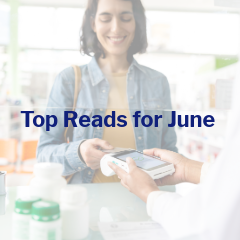
The top three Prescribed Perspectives articles downloaded by health systems in June.
The importance of tracking FMA savings and distributing regular stakeholder communications.
By
Date
September 05, 2024
Read Time
4 minutes

When it comes to specialty medications, the financial burden on patients can be overwhelming at times. In older populations, for example, the American Associated for Retired People (AARP) found that in 2020, the average annual cost of widely used specialty drugs in certain patient groups was up to 13 times higher than the cost of brand name drugs and nearly 125 times higher than the average annual cost of generic products. Four years later, as the specialty space continues to grow with about 70% of medications up for FDA approval falling into the specialty category, financial toxicity may be higher than ever. This potentially can – and often does – have adverse consequences for patients and health systems alike, from reduced medication adherence and poor outcomes to patient leakage and financial loss.
As a solution, health system specialty pharmacies are increasingly stepping in to ease this burden through various financial medication assistance (FMA) programs. These initiatives include patient financial assistance, rebates, 340B pricing, grants, and patient assistance programs (PAP), all aimed at making costly medications more affordable. In our recently released, exclusive McKesson Health Systems Specialty Pharmacy Research Report, we evaluated several aspects of FMA utilization in the health system specialty pharmacy, including how pharmacies monitor savings generated through FMA, how they’re using and socializing this information, what preferences they have regarding administrative reporting and automation, and more. Here, we’ll look specifically at the importance of tracking FMA savings and distributing regular stakeholder communications for the success of your pharmacy and the health of the patients you serve.
The primary benefit of receiving financial assistance is helping the patient with increased adherence to their prescribed regimens, allowing them to better manage their chronic conditions, which ultimately translates to better results and improved patient retention. As a result, this increases the specialty pharmacy’s ability to demonstrate these outcomes and advocate for expanded access to limited distribution drugs (LDDs).
While the benefits of FMA for the patient and system are widely accepted, one of the less discussed but highly impactful aspects of FMA programs is the importance of closely monitoring and regularly sharing financial savings information with key stakeholders, like the C-Suite and executive leadership team. Five primary benefits of continuously tracking savings and reporting findings include:
Transparency and accountability
Regular updates create a transparent environment where health system leaders can see the substantial benefits of financial assistance programs and pharmacy leaders uphold their responsibility to advocate for patients, prevent leakage, and support the financial integrity of the system.
Stakeholder engagement
Sharing financial savings with health system leadership keeps stakeholders informed about the pharmacy’s dedicated efforts to reduce patient costs, help improve patient and financial outcomes, reduce leakage, and expand access to LDDs. This kind of reporting ensures that decision-makers understand the far-reaching value these programs bring, which can support future funding and resources.
Operational efficiency
Knowing exactly how much is being saved (and where) allows pharmacies to better improve their processes. With 83% of our research respondents regularly measuring savings and 93% of those sharing the results with leadership, there’s a clear trend toward using data to drive smarter operations. Still, there may be room for improvement, as 76% of respondents indicated a desire for financial assistance programs to be at least somewhat automated during adjudication – rather than at the point of dispensing. This group also expressed 92% approval for incorporating patient financial assistance of specialty medication dispensing during adjudication – and generally perceived it as “extremely beneficial.”
Strategic planning
Detailed financial reports, including financial savings and administrative time spent on FMA efforts, help specialty pharmacies plan more effectively. This data aids in budgeting and ensures that resources are allocated where they can make the most impact, ultimately benefiting both patients and the pharmacy.
Monitoring and sharing financial savings information isn’t just a bureaucratic exercise; it’s a valuable and worthwhile practice that enhances transparency, engages stakeholders, improves operational efficiency, and supports strategic planning. By focusing on these aspects, health system specialty pharmacies can continue to advocate for patients and ensure that essential medications are accessible to those who need them most. As Craig Dolan, BSPharm, PharmD, MBA; Vice President, Knowledge Management & Thought Leadership, McKesson Professional & Advisory Services (P&AS) puts it, “Financial medication assistance is more than cost reduction or revenue growth. It’s about ensuring that every patient can access the treatments they need to live healthier, fuller lives. When we remove financial barriers, we can help create improvement in adherence and outcomes – and that can pay dividends to all."
Questions about what opportunities may exist to increase your FMA savings, improve your health system specialty pharmacy operations, or otherwise? Contact us today. For access to the full Specialty Pharmacy Research Report, fill out the form below.